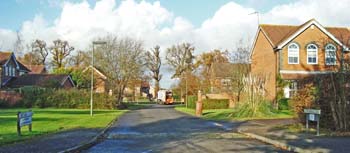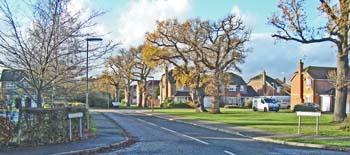Smallfield
Hospital
Broadbridge Lane, Smallfield, Near
Horley, Surrey
Medical
dates:
Medical
character:
Military. Later, acute.
At the beginning of WW2 the
government commissioned Haymills of Wembley to build a hospital along
Broadbridge Lane, Smallfield, for the care of the expected civilian
casualties from London.
The Hospital was located in open countryside, about two miles from Horley. It had 200 beds and was designed on the pavilion plan, with the ward blocks placed along a central walkway.
In November 1941 it was taken over by the Army, who named it the Queen Alexandra Hospital and extended it to 400 beds. It was staffed by the Royal Army Medical Corps (R.A.M.C.).
In April 1942 the War Office agreed to release the Hospital for Canadian use, with effect from 20th May. By 25th May 1942 it was occupied by the No. 14 Canadian General Hospital, a 1200-bed unit established in Montreal which moved from Farnborough. (On 7th November 1943 the troop ship S.S. Elena, carrying 1,870 Canadians, including 121 Nursing Sisters from the No. 14 Canadian General Hospital, was torpedoed off the coast of Tunisia. It sank the following day. Four members of the merchant crew perished.)
After the war the Hospital was taken back by the R.A.M.C. However, negotiations had been initiated by Surrey County Council with the Ministry of Health with a view to taking over the Hospital once the military moved out. The County Council needed the premises to relieve the shortage of floor space at the Redhill County Hospital, which had overcrowded wards and residential quarters and an inadequate Out-Patient Department. The Ministry of Health was prepared to approve this plan, but the military authorities decided to remain in occupation.
The Hospital was finally handed over to the Redhill County Hospital on 19th November 1948. However, Surrey County Council was no longer in charge of the County Hospital, which had joined the NHS on the 'Appointed Day' in July 1948. The Redhill Group Hospital Management Committee, part of the South West Regional Hospital Board, decided that the Smallfield site should be part and parcel of the Redhill County Hospital, which was about 8 miles away.
As the brick bungalow-type buildings had undergone some years of neglect during and after the war, they had to be renovated and then adapted and re-equipped as a civilian hospital. Some wards were vacated and transformed into an Out-Patients Department. The Nurses' Home, on the opposite side of the central road to the Hospital, was also redecorated and a TV installed in the sitting room. A tennis court for the staff was constructed.
Smallfield Hospital opened on 26th April 1949 as a branch of the Redhill County Hospital. Because of the severe problems in obtaining staff, particularly nurses, the Management Committee decided all staff would be interchangeable between both Hospitals. A new motor coach was purchased to transfer staff between the two sites.
On 31st March 1950 the Hospital had 100 beds, with another 100 planned to be opened by 31st March 1951. It was intended that the Hospital would eventually have 360 beds. Together, it and the County Hospital would have 800 beds for general medical and surgical patients, as well as for maternity, orthopaedic and TB cases and the chronically sick.
In 1952 the Hospital had 183 beds (453 with the Redhill County Hospital). Although it had the funds to open 45 more, it was prevented from doing so by the shortage of nurses.
The site remained difficult for visitors to get to by public transport but, in 1952, the London Transport Executive established a limited bus service on Sundays between the Hospital and Caterham.
By 1958 the Hospital had 203 general beds, but many of the wards were still not in use. A visit by representatives of the King's Fund found that, although the wards themselves were spacious, they lacked bed curtains and sufficient sanitary accommodation. There was no wireless (radio) system for the patients. The children's ward consisted of 2-bed glass cubicles down one side of the room and an open ward on the other, with a Day Room at the end. The block containing 8 private patient room was always popular and full, with a weekly charge of £15 plus medical fees. The Hospital had twin operating theatres with plenty of space for ancillary rooms. The teaching rooms of the Preliminary Training School for nurses were large and well-equipped. The general impression of the King's Fund visitors was that the Hospital had plenty of space (perhaps too much) but suffered from remoteness. However, the large car park was full of visitors' cars.
In 1964, when there were 521 beds between the two Hospitals, they came under the control of the Redhill and Netherne Group Hospital Management Committee following the merger of two Management Committees.
Following a major reorganisation of the NHS in 1974, both Hospitals came under the control of the East Surrey District Health Authority, part of the South West Thames Regional Health Authority. Between them, they had 518 beds.
In September 1980 approval was given for the site to be sold.
The Hospital closed in June 1983 with 190 beds. Services were transferred to the newly opened New East Surrey Hospital in Three Arch Road.
The Hospital was located in open countryside, about two miles from Horley. It had 200 beds and was designed on the pavilion plan, with the ward blocks placed along a central walkway.
In November 1941 it was taken over by the Army, who named it the Queen Alexandra Hospital and extended it to 400 beds. It was staffed by the Royal Army Medical Corps (R.A.M.C.).
In April 1942 the War Office agreed to release the Hospital for Canadian use, with effect from 20th May. By 25th May 1942 it was occupied by the No. 14 Canadian General Hospital, a 1200-bed unit established in Montreal which moved from Farnborough. (On 7th November 1943 the troop ship S.S. Elena, carrying 1,870 Canadians, including 121 Nursing Sisters from the No. 14 Canadian General Hospital, was torpedoed off the coast of Tunisia. It sank the following day. Four members of the merchant crew perished.)
After the war the Hospital was taken back by the R.A.M.C. However, negotiations had been initiated by Surrey County Council with the Ministry of Health with a view to taking over the Hospital once the military moved out. The County Council needed the premises to relieve the shortage of floor space at the Redhill County Hospital, which had overcrowded wards and residential quarters and an inadequate Out-Patient Department. The Ministry of Health was prepared to approve this plan, but the military authorities decided to remain in occupation.
The Hospital was finally handed over to the Redhill County Hospital on 19th November 1948. However, Surrey County Council was no longer in charge of the County Hospital, which had joined the NHS on the 'Appointed Day' in July 1948. The Redhill Group Hospital Management Committee, part of the South West Regional Hospital Board, decided that the Smallfield site should be part and parcel of the Redhill County Hospital, which was about 8 miles away.
As the brick bungalow-type buildings had undergone some years of neglect during and after the war, they had to be renovated and then adapted and re-equipped as a civilian hospital. Some wards were vacated and transformed into an Out-Patients Department. The Nurses' Home, on the opposite side of the central road to the Hospital, was also redecorated and a TV installed in the sitting room. A tennis court for the staff was constructed.
Smallfield Hospital opened on 26th April 1949 as a branch of the Redhill County Hospital. Because of the severe problems in obtaining staff, particularly nurses, the Management Committee decided all staff would be interchangeable between both Hospitals. A new motor coach was purchased to transfer staff between the two sites.
On 31st March 1950 the Hospital had 100 beds, with another 100 planned to be opened by 31st March 1951. It was intended that the Hospital would eventually have 360 beds. Together, it and the County Hospital would have 800 beds for general medical and surgical patients, as well as for maternity, orthopaedic and TB cases and the chronically sick.
In 1952 the Hospital had 183 beds (453 with the Redhill County Hospital). Although it had the funds to open 45 more, it was prevented from doing so by the shortage of nurses.
The site remained difficult for visitors to get to by public transport but, in 1952, the London Transport Executive established a limited bus service on Sundays between the Hospital and Caterham.
By 1958 the Hospital had 203 general beds, but many of the wards were still not in use. A visit by representatives of the King's Fund found that, although the wards themselves were spacious, they lacked bed curtains and sufficient sanitary accommodation. There was no wireless (radio) system for the patients. The children's ward consisted of 2-bed glass cubicles down one side of the room and an open ward on the other, with a Day Room at the end. The block containing 8 private patient room was always popular and full, with a weekly charge of £15 plus medical fees. The Hospital had twin operating theatres with plenty of space for ancillary rooms. The teaching rooms of the Preliminary Training School for nurses were large and well-equipped. The general impression of the King's Fund visitors was that the Hospital had plenty of space (perhaps too much) but suffered from remoteness. However, the large car park was full of visitors' cars.
In 1964, when there were 521 beds between the two Hospitals, they came under the control of the Redhill and Netherne Group Hospital Management Committee following the merger of two Management Committees.
Following a major reorganisation of the NHS in 1974, both Hospitals came under the control of the East Surrey District Health Authority, part of the South West Thames Regional Health Authority. Between them, they had 518 beds.
In September 1980 approval was given for the site to be sold.
The Hospital closed in June 1983 with 190 beds. Services were transferred to the newly opened New East Surrey Hospital in Three Arch Road.
Present status (November 2011)
The site was redeveloped for housing in 1992. The new streets were named after Canadian cities and provinces in commemoration of the use of the former Hospital by the Canadian Army during WW2.

Ontario Close.

Toronto Drive.
http://en/wikipedia.org
http://freepages.genealogy.rootsweb.ancestry.com
http://hansard.millbanksystems.com (1)
http://hansard.millbanksystems.com (2)
http://hansard.millbanksystems.com (3)
http://legionmagazine.com
www.burstowpc.co.uk
www.collectionscanada.gc.ca
www.francisfrith.com
www.geocaching.com
www.ibiblio.org
www.perthregiment.org
www.tandridge.gov.uk
Return to home page